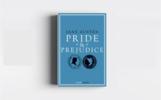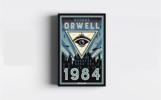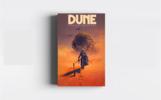As a devoted lover of classical literature, few works
resonate with me as profoundly as Emily Bronte's
"Wuthering Heights." Published in 1847, this timeless
novel has etched its place in the annals of literary
history as a brooding masterpiece that delves into the
darkest corners of the human soul. In this expansive
exploration, I invite you to join me on a journey
through the haunting moors of Wuthering Heights and
Thrushcross Grange, where love, revenge, and the
supernatural intertwine to create a narrative that
transcends time.
To truly grasp the essence of
"Wuthering Heights," one must first immerse oneself in
the atmospheric landscape that Bront meticulously
paints. The desolate moors of Yorkshire serve as the
backdrop to a tale of tumultuous love and unrestrained
passion. Bronte's portrayal of the harsh, windswept
terrain mirrors the emotional turbulence of the
characters inhabiting Wuthering Heights and its
neighboring estate, Thrushcross Grange.
The
isolated and foreboding nature of the landscape becomes
a metaphor for the tumultuous relationships that unfold
within the novel. The desolation and wild beauty of the
moors echo the untamed spirits of Heathcliff and
Catherine Earnshaw, two central characters whose love
story is as tumultuous and untamable as the winds that
sweep across the moors.
Heathcliff, the dark and
enigmatic protagonist of "Wuthering Heights," stands as
a testament to Bronte's ability to craft characters of
unparalleled complexity. Adopted into the Earnshaw
family as a child, Heathcliff's origins remain shrouded
in mystery, adding an air of intrigue and uncertainty to
his persona.
Heathcliff's brooding intensity and
fierce passion make him a character both captivating and
unsettling. As a lover of classical literature, I find
in Heathcliff a figure reminiscent of the tragic heroes
of ancient epics - a soul tormented by love and revenge,
driven to the edges of morality by the harsh
circumstances of his upbringing. His undying love for
Catherine, and the vengeful darkness that consumes him
when she is torn from him, creates a character that
lingers in the reader's psyche long after the last page
is turned.
At the core of "Wuthering Heights"
lies a love story that defies societal norms and
challenges the boundaries of the human heart. The bond
between Heathcliff and Catherine Earnshaw is not a
conventional tale of romance but a tempestuous force
that transcends the boundaries of life and death.
Their love is wild, all-consuming, and at times,
destructive. It defies societal expectations and moral
norms, presenting a narrative that is both disturbing
and deeply moving. As a lover of classical literature, I
appreciate the novel's departure from the conventional,
offering a portrayal of love that is as turbulent and
unpredictable as the moors themselves.
Catherine's famous declaration, "Whatever our souls are
made of, his and mine are the same," encapsulates the
intensity of their connection. The intertwining of their
fates echoes the tragic unions of classical literature,
where love becomes a force that shapes destinies and
challenges the very fabric of existence.
In
contrast to the rugged Wuthering Heights, Thrushcross
Grange symbolizes the ordered and refined world of
societal conventions. The Lintons, the residents of
Thrushcross Grange, embody the societal expectations and
norms prevalent during the Victorian era. Edgar Linton,
Catherine's husband, represents the socially acceptable
choice - a man of wealth, breeding, and genteel manners.
The juxtaposition of the two estates serves as a
commentary on societal expectations and the consequences
of defying them. As a lover of classical literature, I
appreciate Bronte's exploration of the clash between the
untamed passions of Wuthering Heights and the restrained
civility of Thrushcross Grange. This dichotomy reflects
the broader societal struggles and the tension between
individual desires and societal norms - a theme that
resonates across centuries and genres.
"Wuthering
Heights" incorporates an intriguing supernatural element
that adds an additional layer of complexity to the
narrative. The ghostly appearances of Catherine's
spectral figure haunting the moors and Heathcliff's
unwavering belief in the afterlife contribute to the
novel's eerie ambiance.
The presence of the
supernatural in "Wuthering Heights" invites readers to
contemplate the boundaries between reality and the
ethereal. It harkens back to the gothic traditions of
classical literature, where the supernatural serves as a
vehicle for exploring the depths of human emotion and
the unresolved conflicts that linger beyond the grave.
One of the unique features of "Wuthering Heights" is
its narrative structure, which unfolds through a series
of nested narratives. The story is presented through the
eyes of Mr. Lockwood, a newcomer to the region, who
becomes a witness to the mysterious events transpiring
at Wuthering Heights. Nelly Dean, the housekeeper,
serves as the primary narrator, recounting the events
from her perspective.
This multi-layered
narrative technique adds a layer of intricacy to the
storytelling, allowing readers to view events from
different angles. It reflects the oral storytelling
traditions of classical literature, where tales were
passed down through generations, each narrator adding
their own perspective to the unfolding narrative.
Bront masterfully crafts characters with shades of
moral ambiguity, challenging readers to navigate the
murky waters of right and wrong. Heathcliff, in
particular, stands as a character whose actions elicit
both empathy and condemnation. As a lover of classical
literature, I appreciate the moral complexity that
Bront injects into her characters, steering away from
simplistic depictions of good and evil.
The characters in "Wuthering Heights" defy easy
categorization, and their motivations are often
shrouded in ambiguity. This moral complexity invites
readers to reflect on the nature of humanity,
morality, and the consequences of unchecked passion.
It aligns with the classical tradition of presenting
characters with multifaceted personalities,
encouraging readers to grapple with the complexities
of the human psyche.






